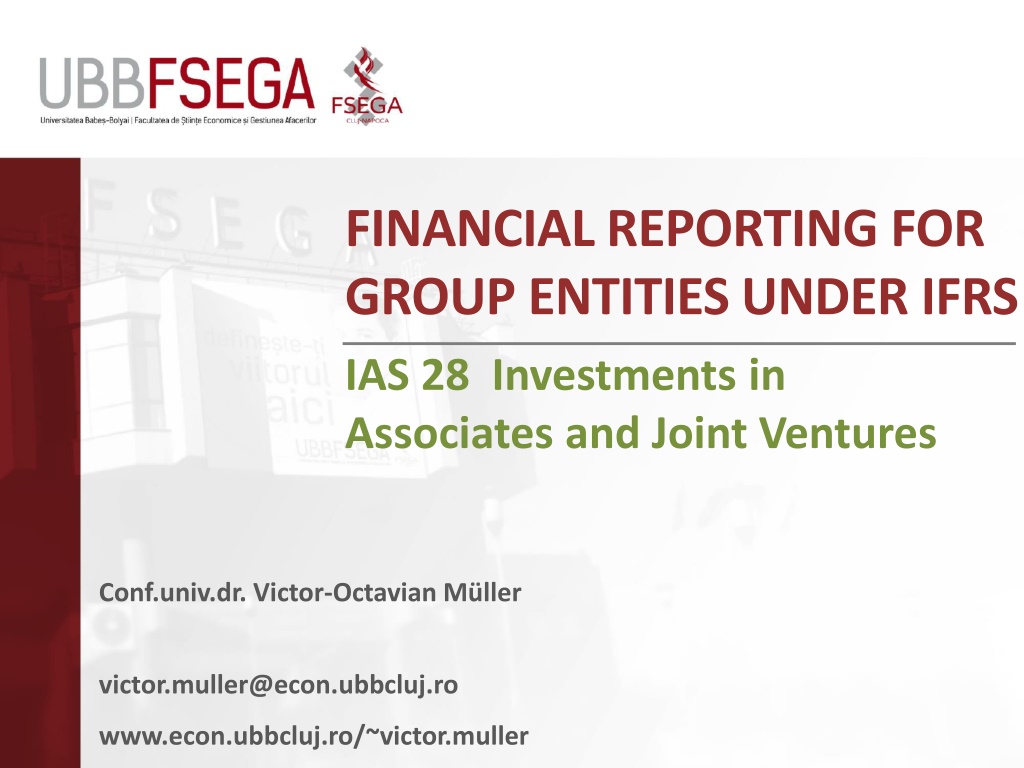Overview of IAS 28: Investments in Associates and Joint Ventures
IAS 28 prescribes accounting for investments in associates and joint ventures, detailing the equity method application. It defines associates as entities with significant influence over investees' financial and operational decisions. The standard is applicable to investors with significant influence or joint control over investees, ensuring proper reporting and disclosures.
Download Presentation

Please find below an Image/Link to download the presentation.
The content on the website is provided AS IS for your information and personal use only. It may not be sold, licensed, or shared on other websites without obtaining consent from the author. Download presentation by click this link. If you encounter any issues during the download, it is possible that the publisher has removed the file from their server.
E N D
Presentation Transcript
FINANCIAL REPORTING FOR GROUP ENTITIES UNDER IFRS IAS 28 Investments in Associates and Joint Ventures Conf.univ.dr. Victor-Octavian M ller victor.muller@econ.ubbcluj.ro www.econ.ubbcluj.ro/~victor.muller
Overview The objective of IAS 28 (as amended in 2011) is to prescribe the accounting for investments in associates and joint ventures IAS 28 sets out the requirements for the application of the equity method to investments in associates and joint ventures. IAS 28 defines an associate by reference to the concept of "significant influence", which requires power to participate in financial and operating policy decisions of an investee (but not joint control or control of those polices). IAS 28 applies to all entities that are investors with joint control of, or significant influence over, an investee (associate or joint venture).
Brief History of IAS 28 Exposure draft (ED) 28 Accounting for Investments in Associates and Joint Ventures July 1986 Standard IAS 28 Accounting for Investments in Associates April 1989 Standard IAS 28 Investments in Associates Dec. 2003 Standard IAS 28 Investments in Associates and Joint Ventures (2011) (supersedes IAS 28 (2003) May 2011 Amendments to IAS 28 by different IASB projects 2014 - 2016 Amendments under consideration by the IASB 2012 2017
Key terms The contractually agreed sharing of control of an arrangement, which exists only when decisions about the relevant activities require the unanimous consent of the parties sharing control ASSOCIATE JOINT CONTROL A joint arrangement whereby the parties that have joint control of the arrangement have rights to the net assets of the arrangement An entity over which the investor has significant influence SIGNIFICANT INFLUENCE The power to participate in the financial and operating policy decisions of the investee but is not control or joint control of those policies JOINT VENTURER A party to a joint venture that has joint control of that joint venture JOINT VENTURE EQUITY METHOD A method of accounting whereby the investment is initially recognised at cost and adjusted thereafter for the post-acquisition change in the investor's share of the investee's net assets. JOINT ARRANGEMENT An arrangement of which two or more parties have joint control
Significant influence (1) Where an entity holds 20% or more of the voting power (directly or through subsidiaries) on an investee, it will be presumed the investor has significant influence unless it can be clearly demonstrated that this is not the case. Sometimes it is not straightforward to determine wheter the investor has significant influence or control over the investee. There are cases where holding more than 20% but less than 50% still gives the investor the control over the investee. If the holding is less than 20%, the entity will be presumed not to have significant influence unless such influence can be clearly demonstrated. A substantial or majority ownership by another investor does not necessarily preclude an entity from having significant influence.
Significant influence (2) The existence of significant influence by an entity is usually evidenced in one or more of the following ways: The investor has a representation on the board of directors (or other equivalent governing body) of the investee The investor participates in policy-making processes (including dividend decisions) There are material transactions between the investor and its investee There is interchange of managerial personnel between the investor and its investee The investor provides of essential technical information to its investee
Significant influence (3) The existence and effect of potential voting rights that are currently exercisable or convertible, including potential voting rights held by other entities, are considered when assessing whether an entity has significant influence. In assessing whether potential voting rights contribute to significant influence, the entity examines all facts and circumstances that affect potential rights. The loss of significant influence over an investee can occur when the investor loses the power to participate in the financial and operating policy decisions of that investee. An entity loses significant influence over an investee can occur with or without a change in absolute or relative ownership levels.
The equity method of accounting (1) Under the equity method: on initial recognition the investment in an associate or a joint venture is recognised at cost, and Subsequently, the carrying amount is increased or decreased to recognise the investor's share of the profit or loss of the investee after the date of acquisition. The investor's share of the investee's profit or loss is recognised in the investor's profit or loss. Distributions (dividends) received from an investee reduce the carrying amount of the investment. Other adjustments to the carrying amount may also be necessary for changes in the investor's proportionate interest in the investee arising from changes in the investee's other comprehensive income (e.g. to account for changes arising from revaluations of property, plant and equipment and foreign currency translations.)
The equity method of accounting (2) An entity's interest in an associate or a joint venture is determined: solely on the basis of existing ownership interests and, generally, does not reflect the possible exercise or conversion of potential voting rights and other derivative instruments. IFRS 9 Financial Instruments does not apply to interests in associates and joint ventures that are accounted for using the equity method. An investment in an associate or a joint venture is generally classified as non-current asset, unless it is classified as held for sale in accordance with IFRS 5Non-current Assets Held for Sale and Discontinued Operations.
Equity method procedures (1) A group s share in an associate or a joint venture is the aggregate of the holdings in that associate or joint venture by the parent and its subsidiaries. The holdings of the group s other associates or joint ventures are ignored for this purpose. When an associate or a joint venture has subsidiaries, associates or joint ventures, the profit or loss, other comprehensive income and net assets taken into account in applying the equity method are those recognised in the associate s or joint venture s financial statements The respective financial statements include the associate s or joint venture s share of the profit or loss, other comprehensive income and net assets of its associates and joint ventures, after any adjustments necessary to give effect to uniform accounting policies.
Equity method procedures (2) Profits and losses resulting from upstream (associate or joint venture to investor) and downstream (investor to associate or joint venturer) transactions are eliminated to the extent of the investor's interest in the associate or joint venture. When downstream transactions provide evidence of a reduction in the net realisable value of the assets to be sold or contributed, or of an impairment loss of those assets, those (unrealised) losses shall be recognised in full by the investor. When upstream transactions provide evidence of a reduction in the net realisable value of the assets to be purchased or of an impairment loss of those assets, the investor shall recognise its share in those losses.
Equity method procedures (3) An investment is accounted for using the equity method from the date on which it becomes an associate or a joint venture. On acquisition, any difference between the cost of the investment and the entity s share of the net fair value of the investee's identifiable assets and liabilities is accounted as follows: Negative difference Positive difference the resulting goodwill is included in the carrying amount of the investment (amortisation not permitted) any resulting excess is included as income in the determination of the entity's share of the associate or joint venture s profit or loss in the period in which the investment is acquired. Adjustments to the entity's share of the associate's or joint venture's profit or loss after acquisition are made, for example, for depreciation of the depreciable assets based on their fair values at the acquisition date or for impairment losses such as for goodwill or property, plant and equipment.
Equity method procedures (4) The investor or joint venturer should use the financial statements of the associate or joint venture as of the same date as the financial statements of the investor or joint venturer unless it is impracticable to do so. If it is impracticable, the most recent available financial statements of the associate or joint venture should be used, with adjustments made for the effects of any significant transactions or events occurring between the accounting period ends. However, the difference between the reporting date of the associate and that of the investor cannot be longer than three months. If the associate or joint venture uses accounting policies that differ from those of the investor, the associate or joint venture's financial statements are adjusted to reflect the investor's accounting policies for the purpose of applying the equity method.
Equity method procedures (5) If an investor's or joint venturer's share of losses of an associate or joint venture equals or exceeds its interest in the associate or joint venture, the investor or joint venturer discontinues recognising its share of further losses. The interest in an associate or joint venture is the carrying amount of the investment in the associate or joint venture under the equity method together with any long-term interests that, in substance, form part of the investor or joint venturer's net investment in the associate or joint venture. After the investor or joint venturer's interest is reduced to zero, a liability is recognised only to the extent that the investor or joint venturer has incurred legal or constructive obligations or made payments on behalf of the associate. If the associate or joint venture subsequently reports profits, the investor or joint venturer resumes recognising its share of those profits only after its share of the profits equals the share of losses not recognised.
Additional impairment of the net investment After application of the equity method an entity applies IAS 39 Financial Instruments: Recognition and Measurement to determine whether it is necessary to recognise any additional impairment loss with respect to its net investment in the associate or joint venture. If impairment is indicated, the amount is calculated by reference to IAS 36 Impairment of Assets. The entire carrying amount of the investment is tested for impairment as a single asset, that is, goodwill is not tested separately. The recoverable amount of an investment in an associate is assessed for each individual associate or joint venture, unless the associate or joint venture does not generate cash flows independently.
Exemptions from applying the equity method (1) Investors do not need to apply the equity method in one of the following circumstances: Investor is a parent that is exempt from preparing consolidated financial statements by the scope exception of paragraph 4(a) of IFRS 10 or all of the following applies: the entity is a wholly/partially-owned subsidiary of another entity and its other owners have been informed about, and do not object to, the investor not applying the Equity Method the entity s debt or equity instruments are not traded in a public market the entity did not file, nor is it in the process of filing, its financial statements with a securities commission or other regulatory organisation for the purpose of issuing any class of instruments in a public market its ultimate or any intermediate parent produces CFS available for public use that comply with IFRSs
Exemptions from applying the equity method (2) When an investment in an associate or a joint venture is held by an entity that is a venture capital organisation, mutual fund, unit trust or similar entity, then the investor may elect to measure investments in those associates and joint ventures at fair value through profit or loss in accordance with IFRS 9. When the investment, or portion of an investment, meets the criteria to be classified as held for sale, the portion so classified is accounted for in accordance with IFRS 5 (the investor shall not apply the equity method)
Other aspects regarding the equity method Discontinuing the equity method: Use of the equity method should cease from the date that significant influence or joint control ceases: If the investment becomes a subsidiary, the entity accounts for its investment in accordance with IFRS 3 Business Combinations and IFRS 10 If the retained interest is a financial asset, it is measured at fair value and subsequently accounted for under IFRS 9 f an investment in an associate becomes an investment in a joint venture (or vice versa), the entity continues to apply the equity method and does not remeasure the retained interest. Changes in ownership interests: If an entity's interest in an associate or joint venture is reduced, but the equity method is continued to be applied, the entity reclassifies to profit or loss the proportion of the gain or loss previously recognised in other comprehensive income relative to that reduction in ownership interest.




























